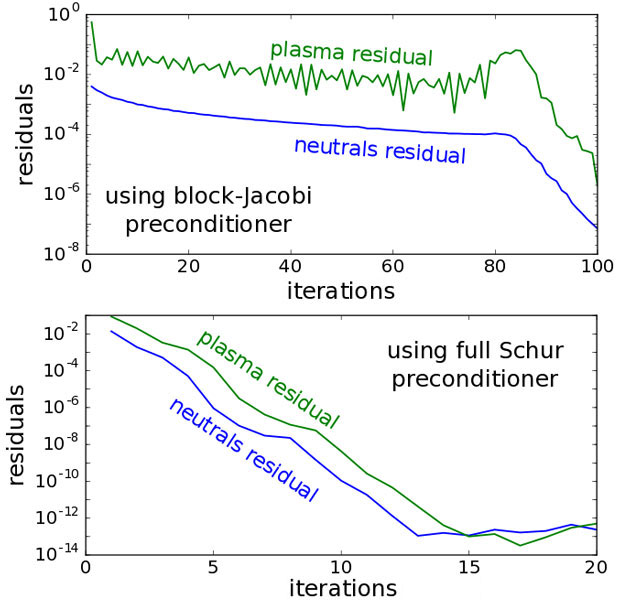Andris Dimits (15-ERD-059)
Project Description
The prediction of magnetic-fusion-energy plasma performance requires accurate modeling of the edge plasma region, which in turn requires accurate coupled treatment of the neutral (atomic) species and charged species (ions and electrons) that inhabit this region. Lawrence Livermore has a highly efficient, implicitly coupled combination of fluid neutrals and plasma models within its two-dimensional, edge-transport code UEDGE. However, these plasma-species models must be coupled to a kinetic neutrals model to achieve sufficient physical fidelity for some important situations. Such neutrals models are based on Monte Carlo techniques, which rely on repeated random sampling to compute results. The coupled combination of plasma-species models with kinetic-neutrals models can be very computationally expensive to run. We are developing an efficient scheme for combining kinetic Monte Carlo and fluid plasma computations for magnetic fusion energy edge simulation. To this end, we will develop new, optimally performing coupling algorithms; implement these for combining established neutral and plasma codes; and verify, demonstrate efficacy of, and validate the algorithms using existing analyzed data from experiments conducted at ITER, an international magnetic-fusion-energy experiment in the south of France intended to prove the viability of magnetic fusion as an energy source.
Our primary goal is to overcome the limitations of current magnetic fusion energy edge-transport codes that prevent wide and routine use of coupled kinetic Monte Carlo neutrals and fluid plasma-transport models, as well as the use of such coupled models as a component of a larger, further-integrated tokamak fusion reactor model. Satisfying this goal would address a very important need for magnetic-fusion-energy progress towards its larger goal of achieving controlled thermonuclear fusion as an energy source. Specifically, we expect to deliver (1) highly efficient and usable, self-consistent Monte Carlo and fluid plasma coupling algorithms, suited for large-scale parallel computing; (2) systematic mathematical stability and convergence-rate analyses of numerical methods for a hierarchy of model problems that capture key aspects of the coupling problem; (3) implementation of the algorithms in coupling a Monte Carlo neutrals code with a fluid plasma code; (4) verification against codes coupled with existing algorithms; and (5) validation against data from relevant experiments.
Mission Relevance
This project directly contributes to Livermore's high-energy-density and high-performance computing, simulation, and data science core competencies by developing expertise in mission-relevant, multiple-timescale, and multiphysics fusion plasma simulations. Our research will enable a solid foundation for improvement of computationally intensive, kinetic-continuum coupling algorithms for mission-critical national security areas such as high-speed rotating gaseous flows, radiation and neutron transport, and spacecraft reentry.
FY16 Accomplishments and Results
In FY16 we (1) implemented implicit approaches in a coupled UEDGE and DEGAS-2 (Monte Carlo code for studying neutral transport in plasmas) code, and verified the resulting code for a key benchmark case; (2) developed preconditioning schemes that are robust across parameter regimes, and analyzed performance of various solver and preconditioner combinations that are practical for coupling involving Monte Carlo (see figure); (3) began implementation in the coupled UEDGE and DEGAS-2 code; (4) extended the one-dimensional Monte Carlo test bed and implemented an implicit coupling strategy; (5) continued work towards robustness of solutions in the implicitly coupled UEDGE and DEGAS-2 code and verified the implicitly coupled code for range of cases; (6) began validation of the code against General Atomics DIII-D tokamak reactor observations, and further developed our approach to demonstrate value for other applications; and (7) translated the coupled UEDGE and DEGAS-2 code to several computational platforms.
Publications and Presentations
- Dimits, A. M., et al., Efficient implicit coupling of fluid-plasma and Monte-Carlo-neutral models for edge plasma transport. 2016 Sherwood Fusion Theory Conf., Madison, WI, Apr. 4–6, 2016. LLNL-POST-687428.
- Joseph, I., et al., Efficient coupling of fluid plasma and kinetic neutral transport models. 22nd Intl. Conf. Plasma Surface Interactions in Controlled Fusion Devices, Rome, Italy, May 30–June 3, 2016. LLNL-ABS-680164.






